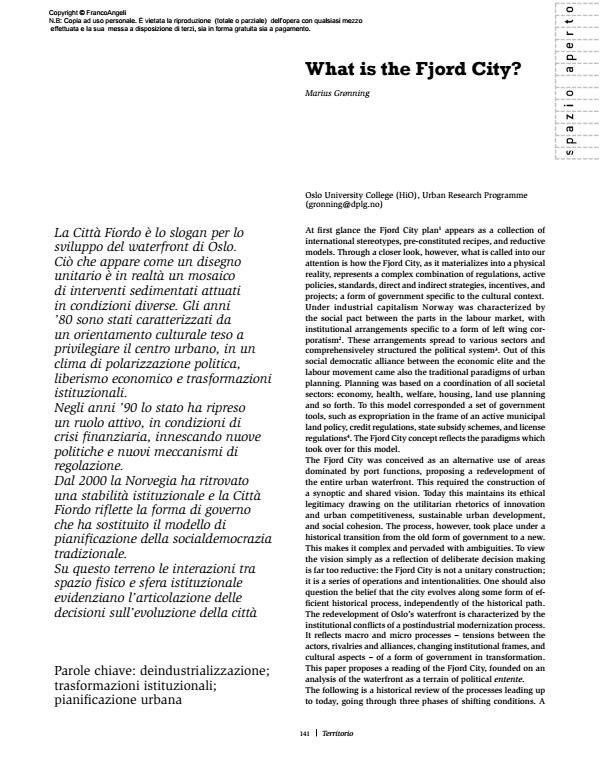What is the Fjord City?
Journal title TERRITORIO
Author/s Marius Grønning
Publishing Year 2011 Issue 2011/56
Language English Pages 10 P. 141-150 File size 1267 KB
DOI 10.3280/TR2011-056022
DOI is like a bar code for intellectual property: to have more infomation
click here
Below, you can see the article first page
If you want to buy this article in PDF format, you can do it, following the instructions to buy download credits

FrancoAngeli is member of Publishers International Linking Association, Inc (PILA), a not-for-profit association which run the CrossRef service enabling links to and from online scholarly content.
Fjord City is the slogan for the development of the Oslo waterfront. What appears as a unified design is in reality a mosaic of interventions implemented gradually under different conditions. The 1980s were characterised by a cultural orientation to give priority to the urban centre in a climate of political polarisation, economic liberalism and institutional transformation. In the 1990’s the state resumed an active role, in conditions offinancial crisis, launching new policies and new regulatory mechanisms. Norway re-established institutional stability in 2000 and Fjord City reflects the form of government that replaced the traditional model of social democratic planning. The organisation of decision-making for the development of the city are to be seen on this ground of interaction between physical space and the institutional sphere.
Keywords: Deindustrialisation; institutional transformations; urban planning
- The social context and politics of large scale urban architecture: Investigating the design of Barcode, Oslo Bengt Andersen, Per Gunnar Røe, in European Urban and Regional Studies /2017 pp.304
DOI: 10.1177/0969776416643751 - L’aménagement d’un centre-ville sans voiture à Oslo : véritable politique de restriction automobile ou simple requalification de l’espace public consécutif à l’effacement du trafic motorisé ? Grégoire Tortosa, in Flux /2022 pp.48
DOI: 10.3917/flux1.127.0048 - The Palgrave Encyclopedia of Urban and Regional Futures Rebecca Cavicchia, Roberta Cucca, pp.1 (ISBN:978-3-030-51812-7)
- La réussite des mesures de restriction automobile dans les villes norvégiennes, résultat d’une convergence nationale imposée et cohérente Grégoire Tortosa, in Revue d’Économie Régionale & Urbaine /2023 pp.59
DOI: 10.3917/reru.231.0059 - Metropolitan Regions, Planning and Governance Daniel Galland, Mark Tewdwr-Jones, pp.195 (ISBN:978-3-030-25631-9)
- The Palgrave Encyclopedia of Urban and Regional Futures Rebecca Cavicchia, Roberta Cucca, pp.1972 (ISBN:978-3-030-87744-6)
- Le péage urbain de Tromsø, l’urbanisme durable à l’épreuve de la périphéricité arctique Grégoire Tortosa, in Cybergeo /2023
DOI: 10.4000/cybergeo.40516
Marius Grønning, What is the Fjord City? in "TERRITORIO" 56/2011, pp 141-150, DOI: 10.3280/TR2011-056022